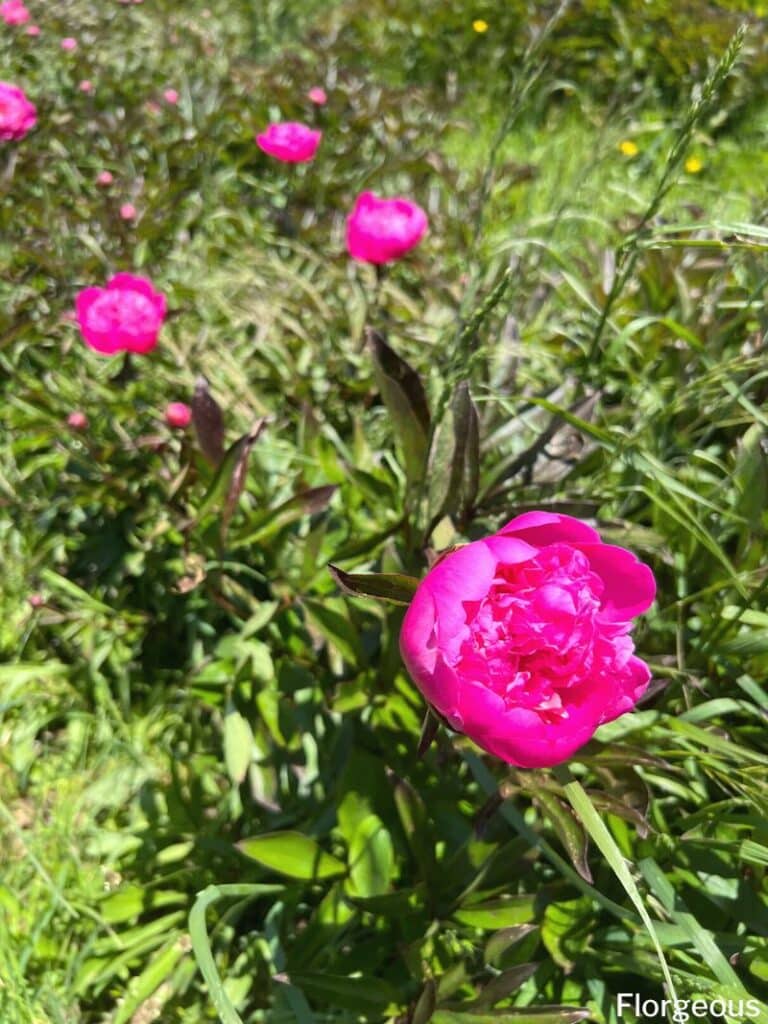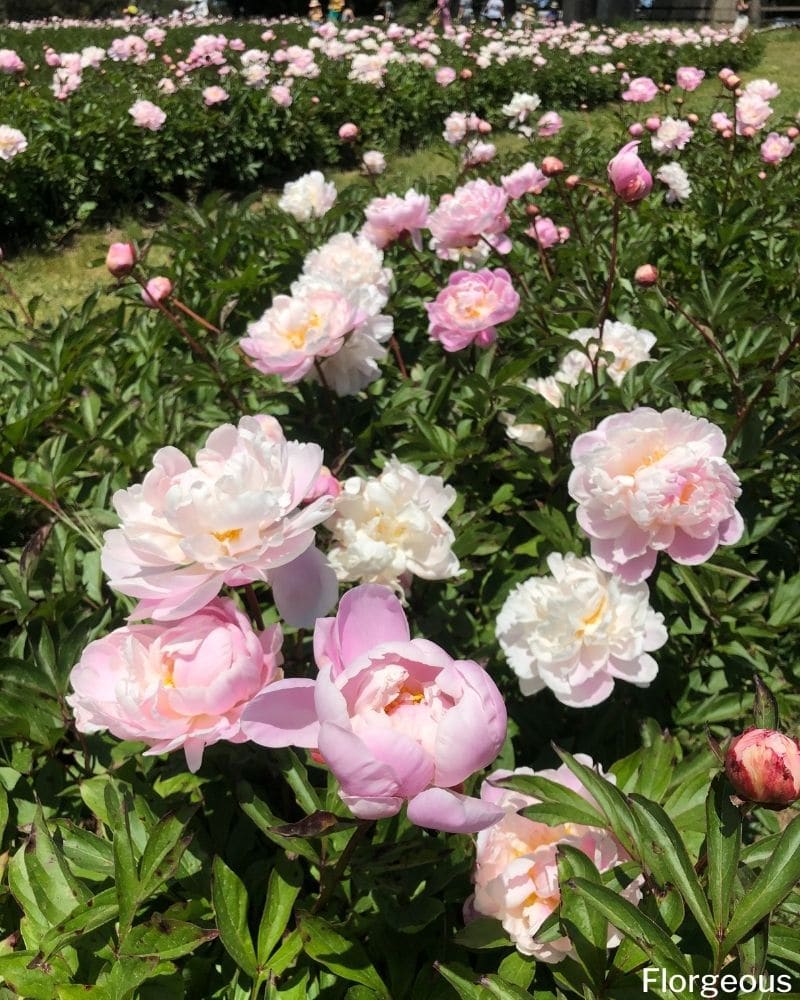Peonies are often grown as a statement piece in front yards and along walkways. The large blooms and colorful flowers leave no room for imagination as to why so many gardeners choose to grow peonies around their homes.
These perennials are also fairly simple to care for, provided they were planted in the appropriate location and have access to the nutrients and water they need.
The peony season varies based on a number of factors, including flower variation and your growing zone.
When choosing what variety to grow, you should take into consideration when you prefer to have your peonies blooming. If you need more information before making your decision, read on!
How Long Does Peony Season Last?
Peony flowers are beautiful, especially when cut for a vase or a special peonies bouquet, but they don’t have a particularly long season—so be sure to take it in while it lasts!
As a general rule, peonies will begin to bloom in late spring and may continue to bloom through early summer; however, this can vary based on the variety you choose and your growing zone.
Each peony bloom will only last around 7 to 10 days, making it even more important to plan out which variety you need to plant.
Pro tip—planting several different varieties of peony flowers can extend the amount of time you have blooming peonies in your yard!
Factors That Influence the Peony Season

As previously mentioned, there are several factors that will influence the peony season. Taking these factors into consideration before planting your peonies can result in overall longer growing seasons as well as the ability to plan out your ideal landscaping.
Here are several factors that affect the season of peonies:
Type of Peony
One of the most influential factors in determining the peony season is the type of peony that you plant. The three primary peony varieties are herbaceous, tree, and intersectional.
Herbaceous peonies are the traditional garden peony flowers that many gardeners would recognize. These peonies generally bloom from late spring to early summer, although there are sub-categories of early season, midseason, and late season varieties that can adjust this range slightly.
Tree peonies, also referred to as woody shrub peonies, are a more hardy version of the herbaceous peony. While this version of the peony is generally more hardy, their growing season isn’t much different than that of the herbaceous peony.
The blooming season for the tree peony is also late spring to early summer; however, the flower blooms themselves are known to bloom for longer periods of time. These blooms are also generally larger than the herbaceous peony flowers.
The other type of peony – the intersectional peony – is a hybrid cross between the herbaceous peony and tree peony. The intersectional peony has the plant structure of the herbaceous peony with the larger flowers of the tree peony.
The blooming season for the intersectional peony falls a few weeks behind the other two variations, meaning it is more likely to bloom in the summer months. Growing intersectional peonies in addition to either of the other two other variations can provide you with peony blooms for a longer overall season.
Region and Climate
Late spring to early summer is the most common blooming season for peonies because they don’t like to bloom in extreme weather.
In early spring, when the days are warm and the nights are above freezing, the peony flowers start to feel comfortable.
However, peonies start to get uncomfortable around the time when those brutally warm days start to hit. For this reason, your particular region or climate can affect the peony bloom time.
The official growing zones for most peonies are zones 3 through 8, although there are some specific varieties that can grow in zone 9 as well. In cooler growing zones where the temperatures stay cool throughout the night further into the year, your peony’s active blooming and growing season may not begin until close to the beginning of May.
While the blooming might not begin until the start of summer, it may last longer into the summer months if your climate typically does not reach the high summer temperatures until later into June or July.
In warmer growing zones, expect your peony’s season to begin closer to the beginning of April, as the risk of overnight frost should be past. Although the bloom season is more likely to start earlier in the year, it may end earlier as well.
Peonies do not tend to grow well once the heat of summer is in full swing, so your season may end early May or even late April if you’re in growing zones 8 or 9.
When it comes to growing season and blooming season of flowers, there is a huge difference between northern and southern hemisphere.
In Australia, peonies normally bloom from late October until mid December. Victoria and Tasmania are the best areas to grow because of the cold winters.

Planting Time: When to Plant Your Peonies
Believe it or not, the time of year you plant your peonies can also have an effect on the bloom time. Most gardeners would probably agree that spring and fall are the ideal planting seasons for a majority of plants, and while the peony is not different, they do have a preference between spring and fall.
While spring-planted peonies can still grow into happy and healthy plants, they may have a harder time establishing themselves. Consequently, if you’ve planted your peonies in the spring, they may have a very short growing season the following year.
On the other hand, peonies that were planted in the fall have an optimal amount of time to become established, and they should be ready for a full bloom by the following spring. These peonies are often able to reach full maturity in a shorter time-frame than spring-planted peonies.
Age
The age of the plant can also have an effect on the bloom time for peony flowers. Older, more established peonies have a better chance of blooming throughout the entire expected growing season—in other words, they can reach their full blooming potential when they are not focusing their resources on growing.
Younger peonies may need to direct more of their nutrients towards growing the stems and leaves of the plant, leaving less energy for creating flowers.
A peony that is still growing may end up with a shorter season overall due to a lack of available energy. However, as long as these peonies are cared for properly and reach full maturity, their bloom time should increase the following season.
Care
It should come as no surprise that a well-cared-for peony has a higher chance of a long growing season.
When it comes to peony care, you need to use the correct soil type and plant them in the right location in regards to available sunlight. These plants would also be fertilized if needed and watered when necessary.
Peonies grown in these conditions will have access to the nutrients needed to create energy that can be used toward creating flowers. Well-cared-for peonies will also be less likely to have damage, meaning they shouldn’t have to focus their energy into repairing their leaves or stems.
On the other hand, a peony that is ignored or incorrectly planted may end up with a shorter active period of growth. This may be due to insufficient nutrients or water availability. If the plant becomes damaged it may also need to reallocate energy toward repair, leaving less energy for creating flowers. A peony that is in very bad condition may not bloom at all.

When Do Peonies Bloom?
Depending on your landscaping plans, you may want to choose peony varieties that are known to bloom either earlier in the season, later in the season, or right in the middle of the season.
You may even want to plant some of each to ensure the longest possible amount of time for having those beautiful peony blooms in your yard.
Below are some examples of peony varieties that grow in early season, midseason, and late season and the colors of peonies.
Early Season
Here are some popular early season peonies to consider.
Athena Peony
The Athena peony is considered to be one of the earliest blooming peony varieties.
This herbaceous peony has an apricot color, and the petals form a cup-shape flower head. All three elements—color, shape, and early blooming time—make this a popular choice.
Early Scout Peony
The Early Scout peony’s name speaks for itself—it is one of the earliest peony varieties to begin blooming. This is another herbaceous variety, and it is generally found with dark red petals on the flower head.
Midseason
Here are some popular midseason peonies to consider.
Pink Derby Peony
Pink derby peonies are a popular choice among the midseason peony options, primarily due to their eye-catching bright pink peonies’ flowers.
The petals on these flower heads form with a layering effect, often making them look ruffled. These peonies are part of the herbaceous variety.
Bride’s Dream Peony
The Bride’s Dream peony is another great choice for a midseason peony. Both the petals and internal petaloids are a bright white, making these flowers stand out against the foliage and other plants growing in your landscaping.
These white peonies are a great pick for weddings, but also for other occasions – like Mother’s Day!
Late Season
Here are some popular late season peonies to consider.
Dinner Plate Peony
If you are looking for a late-season peony to grow, the Dinner Plate variety may be a good choice. This herbaceous peony has flowing petals that resemble that of a rose.
The combination of the larger flower heads and strikingly pink color make these pop during the blooming season.
Nippon Beauty Peony
The Nippon Beauty peony is a popular late-season option due to the high number of blooms they tend to produce. These flowers are a deep red color that form in a cupped shape around the red- and gold-colored middle.
The Nippon Beauty is another herbaceous variety of peony. These are gorgeous peonies for any time of year, but especially to give a dash of festive red charm in December, during the holidays!

Do Peonies Flower More Than Once in a Season?
While peonies only have one blooming season, they will flower multiple times throughout that period. In their first season, your peony plant may only produce one or two flowers; however, this number should increase each season until maturity.
By the second season, you can expect at least five to seven flowers for a healthy plant. For a fully matured peony plant, you may see as many as 20 to 30 flowers.
Regardless of the number of flowers per plant, they are likely to bloom at different times. Each flower may only last for seven to 10 days, but the blooms may stick around for several weeks when blooming in succession.
Where to Find Peonies
Peonies are a popular flower and are likely to be found in nearly any nursery in the spring and fall seasons.
You will probably be able to find peonies at large retailers such as Walmart, Lowes, and Home Depot, although take care with these peonies, they will likely not be as well-kept as a plant from a traditional nursery.
A local plant nursery should be your first stop when looking for a peony. Peonies found in a proper nursery are likely to be healthy and cared for properly.
Many nurseries will also have recommendations about products and care instructions to ensure you give your plant the best chance at a long season with multiple beautiful flowers. However, depending on the size of the nursery, you may have a more limited selection of peony varieties.
If you are looking for a large variety, or are looking for a specific breed that you cannot find locally, there are many online nurseries that will ship your plants.
Unfortunately, you will run a higher risk of shipping damage, although most reputable online companies have a quality guarantee policy to safeguard against accidental damage.
General Tips for Growing and Caring for Peonies
First and foremost, be sure to plant peonies in a suitable location. All peony plants require six to eight hours of sunlight per day as they won’t bloom in the shade. This is important to know when choosing compatible peony companions.
The first step in caring for your peony is planting it in a location with the proper amount of sunlight available. When choosing location, also be sure to give your peony plenty of space, as it doesn’t like to compete with other plants.
Secondly, peonies do best in well-drained soil where water will not pool around the roots. Adding mulch around the base of the peony can also add to the drain ability of the soil. The soil should also be neutral, so you may need to adjust your soil pH if it is too acidic or basic prior to planting.
In general, you should plan on watering your peonies every two weeks once they have matured. If you are receiving more or less rain than usual in a particular season, you can adjust your watering schedule accordingly.
While peonies don’t always require fertilizers, some will benefit from fertilizing once or twice every season, particularly in the spring. Young peonies may benefit the most from fertilizing, as this can give them a boost and encourage growth.
How to Extend Your Peonies Season
Peony flower season is a highlight for many flower gardeners, so it is unfortunate that it lasts for such a short amount of time each year. For those who want to make the most out of peonies season, consider planting multiple different varieties each year. As discussed previously, there are early-season, midseason, and late-season peony varieties.
By planting some peony breeds from each of these categories, you are extending the amount of time you will be able to watch your peony blossoms pop up. By planting many different varieties, you are also able to have several different colored and shaped peonies in your landscaping, adding to the beauty.
As for a single peony plant, the best way to extend the growing season is to make sure you plant it in the fall and care for it as best you can. A well-cared-for peony is likely to last longer than a peony that is not cared for regularly—you may also get more blooms by taking proper care of your peony.
FAQs
Do peonies only bloom once a season?
Peonies typically bloom once a season, usually in late spring to early summer, depending on the variety and climate. The bloom period can last for a couple of weeks, with each flower lasting several days.
Do peonies last all summer?
No, peonies do not last all summer. Once the blooming period is over, the flowers will fade, and the plant will focus on storing energy for the next season’s growth and bloom.
How many seasons does it take for peonies to bloom?
Peonies usually take a few seasons, around 2-3 years, to establish themselves and begin blooming consistently. However, once they start blooming, they can continue to do so annually for many years, provided they are well-cared for and in a suitable location.
Final Thoughts
Overall, the peony makes a beautiful addition to any landscape—assuming you are in the correct growing zone. You may want to consider growing several different varieties to extend the blooming season, as it is relatively short.
Thankfully, there are many options when it comes to peonies, and many bloom at different times, allowing you to stagger the blooming season accordingly. Whether you’re enjoying peonies in your garden beds, creating stunning cut flower arrangements, or simply appreciating their timeless elegance, these perennial flowers add softness and charm to outdoor spaces.
In short, choosing the correct varieties, planning your landscaping properly, and caring for your peonies make all of the difference in extending the lifespan and beauty of your peony flowers.
If you are a fan of peony, here’s a guide about peony symbolism you’ll love to read.







